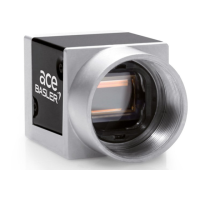AW00118702000 Camera Link Implementation
Basler racer Camera Link 5
1.3 Electrical Implementation
The schematics in Fig. 2 through Fig. 6 on the following pages illustrate the basics of the racer
Camera Link electrical implementation. The basic difference between the schematics is the number
of transmitters used and the port assignments for each transmitter.
Fig. 2 on page 6 illustrates the implementation when a camera is set for the 1X or 1X2 tap geometry,
which will cause it to operate in the base Camera Link configuration. In this situation, only the X
transmitter is used.
Fig. 3 on page 7 illustrates the implementation when a camera is set for the 1X4 tap geometry,
which will cause it to operate in the medium Camera Link configuration. In this situation, the X and
Y transmitters are used.
Fig. 4 on page 8 illustrates the implementation when a camera is set for the 1X8 geometry, which
will cause it to operate in the full Camera Link configuration. In this situation, the X, Y, and Z
transmitters are used. This configuration is commonly referred to as an "octo" configuration
because eight sets of Camera Link ports are mapped to the transmitters.
Fig. 5 on page 9 illustrates the implementation when a camera is set for the 1X10 geometry, which
will cause it to operate in the full Camera Link configuration. In this situation, the X, Y, and Z
transmitters are used. This configuration is commonly referred to as a "deca" configuration because
ten sets of Camera Link ports are mapped to the transmitters.

